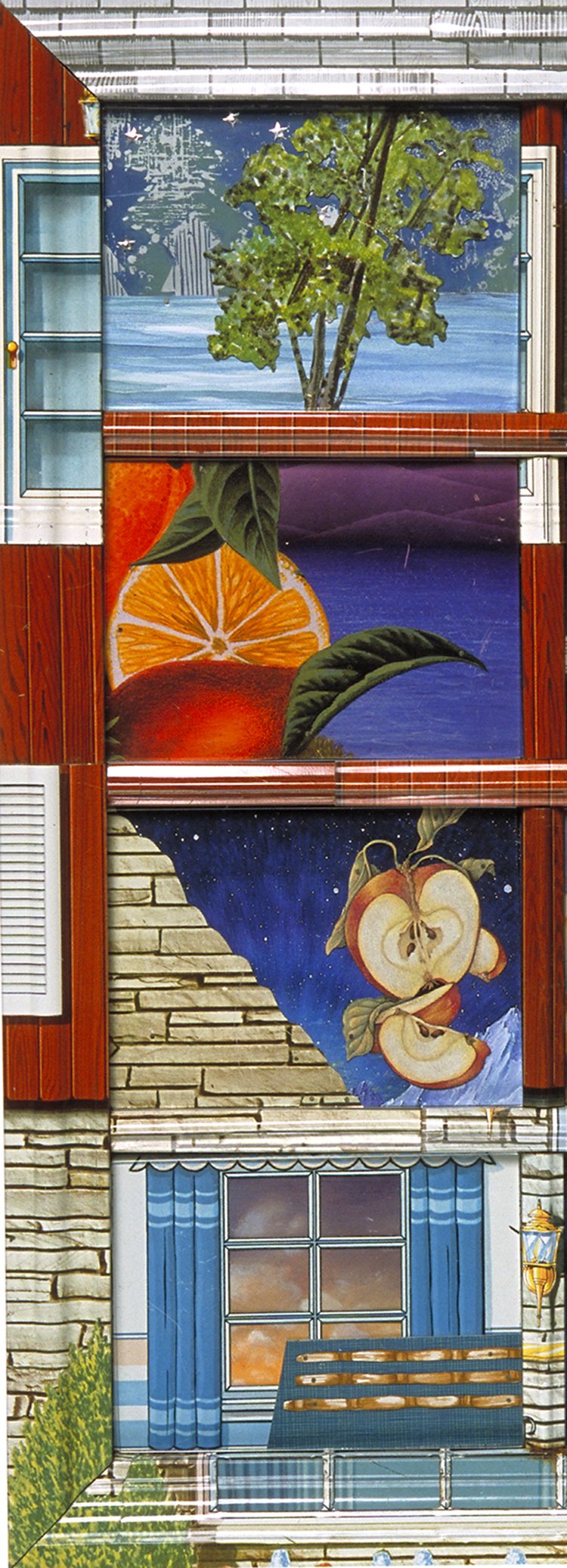For the Child Who Is Unable To Ask,
Thou Shalt Explain the Story of Passover
from the series:
An Orange Belongs on the Seder Plate
Seder plate window frame constructed using vintage steel dollhouses (brown wood siding house with stone). Each window pane image is constructed using recycled tin containers to represent a symbolic food on the Seder table. Additional materials include Plexiglas window panes, 10k. gold rivets, sterling silver rivets, and stainless steel screws
1.75" height x 18.25" length x 12.5"width
Permanent collection of Yeshiva University Museum, New York, NY
Photo Credit for all images on this page: Philip Cohen
Window panes
Window panes are covered with a sheet of Plexiglas that is removable. This is so the tin cans are protected and the Seder Plate is practical to use.
In the images below, you can see each one of the symbolic foods placed on the Seder plate and discussed during the Seder service.
The green is to represent parsley. Parsley is a symbol of spring green and is eaten during the Seder service dipped in salt water.
An orange is placed on my Seder plate as a symbol of inclusivity in Jewish religious leadership. The initial discussion around including an orange was about including women in religious leadership, but has been extended to the inclusion of gay, lesbian, and all genders including women.
The apples represent the haroses which is made from chopped apples, raisins, and wine. This is supposed to remind us of the mortar used to make the bricks for building the pyramids of Egypt.
At the bottom of this image, you can see the three matzo on the table - representing the three matzo set aside during the Seder service.
A shank bone is placed on the Seder table. It is shown on the right as a bone and lamb. This refers to the original type of ritual “sacrifice” at the temples 2,000 or more years ago.
In ancient times, there was a paschal offering brought to the Temple in Jerusalem.
Horseradish root is symbolic of the bitterness our ancestors experienced as slaves in Egypt. Usually, everyone puts ground, prepared horseradish or a piece of horseradish root with some Charoses on their matzo and eats it during the Seder service.
The horseradish is very pungent bringing tears to your eyes.
Grapes are not usually on a Seder plate, but it is always part of the Seder service. You are supposed to drink four cups of wine. Even the children are allowed some sweet wine or grape juice at Seder.
A roasted egg is always on the seder plate. Traditionally, a hard-boiled egg is a symbol of the continuing cycle of life. In addition, some see the egg as a symbol of spring, rebirth, and the Jewish people’s willingness to survive in persecution.
We think of eggs as available year around, but before electricity in the hen house and artificial lighting, the hens stopped laying eggs in the winter. This is why eggs are a symbol of spring….because the hens would not lay eggs again until the days were longer.
For the Child Who Is Unable To Ask, Thou Shalt Explain the Story of Passover
Seder plate was featured on the cover of NA'AMAT Woman Magazine, Spring 2009
© Harriete Estel Berman, 2000-2001, 2021, 2023




